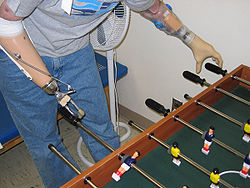Visit and Join the WeHeal Prosthetic Legs and Feet Community
Click here for a list of clinical trials currently recruiting
For more information, see: WebMD | Wikipedia

In medicine, a prosthesis (plural: prostheses; from Ancient Greek prósthesis, “addition, application, attachment” is an artificial device that replaces a missing body part, which may be lost through trauma, disease, or congenital conditions. Prosthetic amputee rehabilitation is primarily coordinated by a prosthetist and an inter-disciplinary team of health care professionals including psychiatrists, surgeons, physical therapists, and occupational therapists.
A person’s prosthesis should be designed and assembled according to the patient’s appearance and functional needs. For instance, a patient may need a transradial prosthesis, but need to choose between an aesthetic functional device, a myoelectric device, a body-powered device, or an activity specific device. The patient’s future goals and economical capabilities may help them choose between one or more devices.
Craniofacial prostheses include intra-oral and extra-oral prostheses. Extra-oral prostheses are further divided into hemifacial, auricular (ear), nasal, orbital and ocular. Intra-oral prostheses include dental prostheses such as dentures, obturators, and dental implants.
Prostheses of the neck include larynx substitutes, trachea and upper esophageal replacements,
Somato prostheses of the torso include breast prostheses which may be either single or bilateral, full breast devices or nipple prostheses.
Lower-extremity prostheses provide replacements at varying levels of amputation. These include hip disarticulation, transfemoral prosthesis, knee disarticulation, transtibial prosthesis, Syme’s amputation, foot, partial foot, and toe. The two main subcategories of lower extremity prosthetic devices are trans-tibial (any amputation transecting the tibia bone or a congenital anomaly resulting in a tibial deficiency) and trans-femoral (any amputation transecting the femur bone or a congenital anomaly resulting in a femoral deficiency).
A transfemoral prosthesis is an artificial limb that replaces a leg missing above the knee. Transfemoral amputees can have a very difficult time regaining normal movement. In general, a transfemoral amputee must use approximately 80% more energy to walk than a person with two whole legs.[2] This is due to the complexities in movement associated with the knee. In newer and more improved designs, hydraulics, carbon fiber, mechanical linkages, motors, computer microprocessors, and innovative combinations of these technologies are employed to give more control to the user. In the prosthetic industry a trans-femoral prosthetic leg is often referred to as an “AK” or above the knee prosthesis.[3]
A transtibial prosthesis is an artificial limb that replaces a leg missing below the knee. A transtibial amputee is usually able to regain normal movement more readily than someone with a transfemoral amputation, due in large part to retaining the knee, which allows for easier movement. Lower extremity prosthetics describes artificially replaced limbs located at the hip level or lower. In the prosthetic industry a trans-tibial prosthetic leg is often referred to as a “BK” or below the knee prosthesis.
Visit and Join the WeHeal Prosthetic Legs and Feet Community
For more information, see: WebMD | Wikipedia
WeHeal is very grateful to our valued sources of information which include Wikipedia, WebMD, ClinicalTrials.gov, Cancer.gov, Infoplease, and the US CDC (Center for Disease Control).